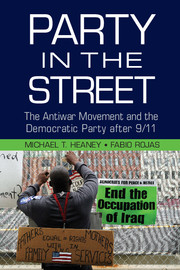Book contents
- Frontmatter
- Dedication
- Contents
- List of Tables
- List of Figures
- List of Abbreviations
- Introduction
- 1 The Party in the Street and Its Historical Context
- 2 Partisan Politics at the Water's Edge?
- 3 Multiple Identities and Party-Movement Interaction
- 4 Identities and Grassroots Participation
- 5 Identities and Organizational Action
- 6 Identities and Legislative Agendas
- 7 Beyond the Antiwar Movement and the Democratic Party
- 8 Social Movements in a Polarized America
- Epilogue
- Appendixes
- References
- Index
4 - Identities and Grassroots Participation
Published online by Cambridge University Press: 05 February 2015
- Frontmatter
- Dedication
- Contents
- List of Tables
- List of Figures
- List of Abbreviations
- Introduction
- 1 The Party in the Street and Its Historical Context
- 2 Partisan Politics at the Water's Edge?
- 3 Multiple Identities and Party-Movement Interaction
- 4 Identities and Grassroots Participation
- 5 Identities and Organizational Action
- 6 Identities and Legislative Agendas
- 7 Beyond the Antiwar Movement and the Democratic Party
- 8 Social Movements in a Polarized America
- Epilogue
- Appendixes
- References
- Index
Summary
On the morning of Monday, January 21, 2013, a few hundred thousand people gathered on the National Mall to witness the second inauguration of President Barack Obama. At the same time, about 150 activists assembled three miles away at the south entrance to Meridian Hill Park in Washington, D.C. (Hatic 2013). The rally was spearheaded by the longtime Washington, D.C. activists Joan Stallard and Malachy Kilbride and organized under the banner of the newly formed Arc of Justice Coalition. Seizing upon the coincidence of Inauguration Day and Martin Luther King Jr. Day, the coalition borrowed its name from a well-known statement of King's (1965) that “the arc of the moral universe is long, but it bends toward justice.” The coalition was formally endorsed by eighteen organizations of the antiwar movement of the past decade, such as Code Pink, MoveOn, Veterans for Peace, Peace Action, United for Peace and Justice, World Can't Wait, and the Backbone Campaign.
The Arc of Justice contingent marched down 16th Street, toward the inaugural ceremonies (pictured in Figure 4.1). Participants carried banners that stressed antiwar themes, such as “Obama: Earn Your Nobel Peace Prize,” “Drones Kill Thousands of Non-Combatants,” “End War Now!” and “Crimes Are Crimes No Matter Who Does Them” (with accompanying photos of Presidents Bush and Obama). Activists from World Can't Wait had a series of giant model drones to emphasize their opposition to the Obama administration's increased use of remote control drones as weapons in the War on Terror. The march proceeded with the supervision of three uniformed police officers, one marked police car, and a few unmarked police cars with plainclothes officers.
- Type
- Chapter
- Information
- Party in the StreetThe Antiwar Movement and the Democratic Party after 9/11, pp. 94 - 130Publisher: Cambridge University PressPrint publication year: 2015



